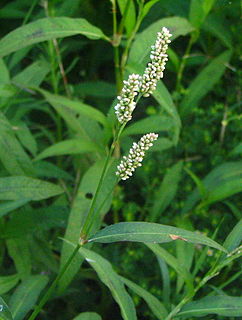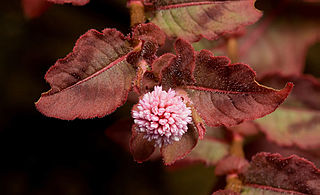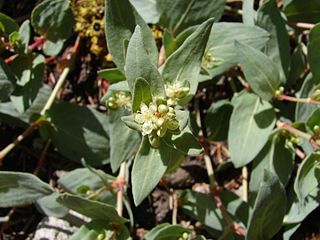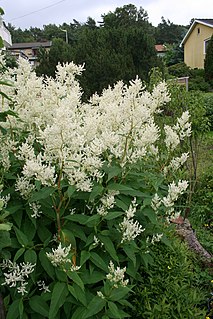
The Polygonaceae are a family of flowering plants known informally as the knotweed family or smartweed—buckwheat family in the United States. The name is based on the genus Polygonum, and was first used by Antoine Laurent de Jussieu in 1789 in his book, Genera Plantarum. The name may refer to the many swollen nodes the stems of some species have, being derived from Greek, poly meaning 'many' and gony meaning 'knee' or 'joint'. Alternatively, it may have a different derivation, meaning 'many seeds'.

Persicaria is a genus of herbaceous flowering plants in the knotweed family, Polygonaceae. Plants of the genus are known commonly as knotweeds or smartweeds. It has a cosmopolitan distribution, with species occurring nearly worldwide. The genus was segregated from Polygonum.

Polygonum is a genus of about 130 species of flowering plant in the buckwheat and knotweed family Polygonaceae. Common names include knotweed and knotgrass. In the Middle English glossary of herbs Alphita, it was known as ars-smerte. There have been various opinions about how broadly the genus should be defined. For example, buckwheat has sometimes been included in the genus as Polygonum fagopyrum. Former genera such as Polygonella have been subsumed into Polygonum; other genera have been split off.

Fallopia is a genus of about 12 species of flowering plants in the buckwheat family, often included in a wider treatment of the related genus Polygonum in the past, and previously including Reynoutria. The genus is native to temperate and subtropical regions of the Northern Hemisphere, but species have been introduced elsewhere. The genus includes species forming vines and shrubs.

Oxyria is a genus of plants in the family Polygonaceae with three accepted species as of March 2019. It has a circumboreal distribution.

Koenigia is a genus of plants in the family Polygonaceae. The genus Aconogonon has been merged into Koenigia.

Prunus campanulata is a species of cherry native to Japan, Taiwan, southern and eastern China, and Vietnam. It is a large shrub or small tree, growing 3–8 m (10–26 ft) tall. It is widely grown as an ornamental tree, and a symbol of Nago in the Ryukyu Islands of Japan. It is variously known in English as the Taiwan cherry, Formosan cherry, or bellflower cherry. It was described in 1883 by Carl Johann Maximowicz.

Bistorta is a genus of flowering plants in the family Polygonaceae. As of February 2019 about 40 species are accepted. It has been supported as a separate clade by molecular phylogenetic analysis. Bistorta species are native throughout much of the Northern Hemisphere, as far south as Mexico in North America and Thailand in Asia.

Koenigia weyrichii, the Chinese knotweed or Weyrich's knotweed, is a large, perennial, rhizomatous herb native to East Asia.
Polygonum delopyrum, the fringed jointweed or hairy jointweed, is a plant species endemic to Florida. It is found in pinelands and sandy pine barrens at elevations less than 50 m, in central and southern parts of the state.

Polygonum serotinum, commonly called southern jointweed or American jointweed, is a species of flowering plant in the knotweed family. It is native to Southeastern United States extending in scattered locations west to New Mexico. Its preferred habitat is dry, sandy areas.

Koenigia davisiae is a flowering plant in the knotweed family that is known by the common names Davis' knotweed or Newberry knotweed.

Koenigia alpina, commonly known as alpine knotweed, is similar to Koenigia alaskana, but differs in leaf size and achene characteristics. It is native to Europe and temperate Asia.

Koenigia alaskana is an Asian and North American species of flowering plant in the buckwheat family known by the common names Alaska wild-rhubarb and alpine knotweed.

Koenigia phytolaccifolia is a species of flowering plant in the knotweed family, known by the common name poke knotweed.

Koenigia polystachya is a species of flowering plant in the knotweed family, known by the common names Himalayan knotweed and cultivated knotweed. It has several regularly used synonyms, including Polygonum polystachyum, Aconogonon polystachyum and Persicaria wallichii.
Septobasidium polygoni is a plant pathogenic fungus in the genus Septobasidium. It was first isolated from Koenigia campanulata.

Tanja Magdalena Schuster is a taxonomist from Kaindorf, Austria and the first Pauline Ladiges Plant Systematics Fellow, holding a joint position with the School of Biosciences, University of Melbourne, Victoria, Australia, and the National Herbarium of Victoria, Royal Botanic Gardens Melbourne. Schuster also worked as curator of the Norton-Brown Herbarium at the University of Maryland, College Park.

Koenigia mollis is a species of flowering plant in the family Polygonaceae, native to the eastern Himalayas and Myanmar.

Koenigia × fennica, known as Finnish knotweed, is a hybrid between two species of Koenigia, K. alpina and K. weyrichii, members of the family Polygonaceae, the knotweed family. It generally only known as a cultivated garden plant, but plants have been recorded a few times surviving in abandoned areas in northern Europe, especially in Finland. The cultivar 'Johanniswolke' is considered an attractive ornamental perennial plant.















